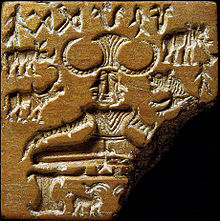Pashupati
| Pashupati | |
|---|---|
Lord of the Animals | |
 The Pashupati seal, showing a seated and possibly ithyphallic figure, surrounded by animals. | |
| Affiliation | Incarnation of Shiva |
| Region | India and Nepal |
| Part of a series on |
| Shaivism |
|---|
 |
|
|
Pashupati (Sanskrit Paśupati) is an incarnation of the Hindu god Shiva as "lord of the animals". He is revered throughout the Hindu world, but especially in Nepal, where he is unofficially regarded as a national deity.
Etymology
Paśupati "Lord of all animals" was originally an epithet of Rudra in the Vedic period[1] and now is an epithet of Shiva.[2] The Rigveda has the related term paśupa "cattle-keeping" as an epithet for Pushan.
| Part of a series on |
| Hinduism |
|---|
 |
The Deity
Pashupatinath is an avatar of Shiva, one of the Hindu Trinity. He is the male counterpart of Shakti.
The five faces of Pashupatinath represent various incarnations of Shiva; Sadyojata (also known as Barun), Vamdeva (also known as Uma Maheswara), Tatpurusha, Aghor & Ishana. They face West, North, East, South and Zenith respectively, and represent Hinduism's five primary elements namely earth, water, air, light and ether.[3]
Puranas describe these faces of Shiva as [3]
Sadyojata, Vamdeva, Tatpurusha & Aghora are the four faces, The fifth is Ishana, unknowable even to the seers
Pashupatinath in Nepal

Though Nepal is an officially secular state, its population is predominantly Hindu, and Lord Shree Pashupatinath is revered as a national deity. The Pashupatinath Temple, located at the bank of the river Bagmati, is considered the most sacred place in Nepal. The mythology hold that Lord Pashupatinath started living in Nepal in the form of a deer, when he saw the Kathmandu Valley and was overwhelmed by its beauty.
Pashupatinath in India

A Pashupatinath temple is sited on the banks of the Shivana river in Mandsaur, Madhya Pradesh, India. It is one of the most prominent shrines in Mandsaur, and Lord Shiva in the form of Lord Pashupatinath is its primary deity. Its main attraction is a unique Shiva Linga displaying eight faces of Lord Shiva. The shrine has four doors, representing the cardinal directions.[4]
See also
Notes
- ^ Kramrisch, p. 479.
- ^ Sharma, p. 291.
- ^ a b Encyclopaedia of Saivism, Swami P. Anand, Swami Parmeshwaranand, Publisher Sarup & Sons, ISBN 8176254274, ISBN 9788176254274, page 206
- ^ Pashupatinath Temple website
References
- Flood, Gavin (1996). An Introduction to Hinduism. Cambridge: Cambridge University Press. ISBN 0-521-43878-0.
{{cite book}}: Cite has empty unknown parameter:|coauthors=(help) - Flood, Gavin (Editor) (2003). The Blackwell Companion to Hinduism. Malden, Massachusetts: Blackwell. ISBN 1-4051-3251-5.
{{cite book}}:|first=has generic name (help); Cite has empty unknown parameter:|coauthors=(help) - Kramrisch, Stella (1981). The Presence of Śiva. Princeton, New Jersey: Princeton University Press. ISBN 0-691-01930-4.
{{cite book}}: Cite has empty unknown parameter:|coauthors=(help) - Michaels, Axel (2004). Hinduism: Past and Present. Princeton, New Jersey: Princeton University Press. ISBN 0-691-08953-1.
{{cite book}}: Cite has empty unknown parameter:|coauthors=(help) - Possehl, Gregory (2003). The Indus Civilization: A Contemporary Perspective. AltaMira Press. ISBN 978-0-7591-0172-2.
{{cite book}}: Cite has empty unknown parameter:|coauthors=(help) - Sharma, Ram Karan (1996). Śivasahasranāmāṣṭakam: Eight Collections of Hymns Containing One Thousand and Eight Names of Śiva. With Introduction and Śivasahasranāmākoṣa (A Dictionary of Names). Delhi: Nag Publishers. ISBN 81-7081-350-6.
{{cite book}}: Cite has empty unknown parameter:|coauthors=(help) - This work compares eight versions of the Śivasahasranāmāstotra. The Preface and Introduction (in English) by Ram Karan Sharma provide an analysis of how the eight versions compare with one another. The text of the eight versions is given in Sanskrit. - Zimmer, Heinrich (1972). Myths and Symbols in Indian Art and Civilization. Princeton, New Jersey: Princeton University Press. ISBN 978-0-691-01778-5.
{{cite book}}: Cite has empty unknown parameter:|coauthors=(help)

